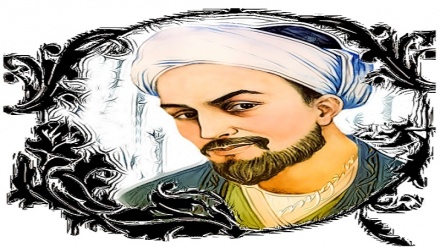Iranian notables, sources of global honor (85)
In this episode we will become familiar with some of the most important experts on the works of acclaimed Iranian philosopher, Sheikh Shahab Ed-Din Sohrawardi, in the West.
Today, we continue to research the works and services rendered by the celebrated and preeminent Iranian mystic and philosopher, Sohrawardi, who lived in 6th Century AH. He highly contributed to development of Islamic philosophy and mysticism, and is the founder of one of the major Islamic philosophy schools of thought “Illuminism”.
Sohrawardi was born in the Village of Sohraward in proximity of Zanjan in the year 549 AH. He was killed in the year 587 AH at the age of 38 upon the conspiracy of scholars in Aleppo, and the order of Founder of Ayoubi Dynasty, Salah Ed-Din Ayoubi. He has left behind 50 works. Some of his works are allegorical stories and treatises in cryptic writing, which according to researchers display the true image of Sohrawardi. In previous weeks, we introduced and researched some of the works of this famed philosopher in Farsi language, and later studied the status of Sohrawardi in the eyes of Western thinkers and philosophers, and the extent of their familiarity with this renowned Iranian philosopher and mystic.
Among the pioneering researchers of the works of Sohrawardi in the West and English speakers, the first and most prominent one is a pundit, who maintains an Iranian descent. Seyed Hussein Nasr began to introduce Sohrawardi to Westerners in the 1950s. He has published and released a number of highly-circulated books on Sohrawardi. The first of these books covers a collection of Sohrawardi’s works in Farsi language, with an Introduction authored by Seyed Hussein Nasr. He has released a large number of articles for introduction of the works and thoughts of Sohrawardi, covering the books of this renowned Iranian mystic in Farsi language.
In one of his articles, Nasr has spoken about the spread of Sufism in the Indian Subcontinent and the West. The article written by Nasr on the history of Islamic philosophy is one of the first detailed and comprehensive articles on this topic in English language.
Majid Fakhri is another Iranian who has written numerous articles on Sohrawardi in Arabic language, in addition to discussing Sohrawardi’s life and works in his book, titled “History of Islamic Philosophy”.
The English Philosopher, Richard Neton, in a number of his works, has mentioned Sohrawardi and has studied the latter’s Neo-Platonic ideological structure, while naming Sohrawardi as a Sufi philosopher.
The majority of the treatises of Sohrawardi in Farsi language were initially translated and published by a researcher of Harvard University, William M. Paxton, with the second edition of these treatises being recently published. It can be said that as the result of such translated texts, the concepts and terms of Illuminism School of Thought have captured the attention of a number of American poets, such as William Blake and William B Yeats. In their poems, these American poets have referred to the notions of Illuminism and have made use of some of the related technical terms.
Late Mahdi Haeri Yazdi, in one of his most important works on Islamic philosophy in English language, has presented a commentary on Sohrawardi’s ideas.
Among the lesser known works on Sohrawardi in English language, one can mention an article authored by Edward Georgi, which has spoken about the revival of Illuminism School of Thought in the new era.
Anthony Towfi, in an article, has studied the usage of symbolism by Sohrawardi in his works and has compared the method adopted by the latter in usage of the symbol of light to the related approach of Iranian figure, Ghazali.
One of the other authors who have researched Sohrawardi’s life and works is John Walbridge. In his recent work, Walbridge has analyzed the parameters and ideological principles of Illuminism School of Thought. Additionally, he has carried out extensive research on the status of Illuminism.
Upon the publication of the works of the contemporary researcher, Henry Corbin, and Seyed Hassan Nasr on Sohrawardi, the attention of countless students was drawn to the life and works of this acclaimed Iranian philosopher, leading a large number of PhD students to choose this topic as the subject of their theses in the year 1970.
Moreover, the Spanish Philosopher, Argus John Manuel, in one of his writings, has mentioned the traces of Sufism in the thoughts of Sohrawardi. Another renowned Spanish Philosopher, Miguel Hernandez, in his signature book, has studied the spiritual symbolism in Sohrawardi’s thoughts, comparing this with the symbolism applied by Iranian-Islamic genius, Avicenna. Meanwhile, in the introduction of the works of Spanish speakers on the life and books of Sohrawardi, mention should also be made of the young Argentinean researcher, Andria de Vita, whose PhD treatise is about Sohrawardi. This young researcher also intends to translate and publish some of the works of this preeminent Iranian philosopher and mystic into Spanish language.
Valuable books on the life and works of Sohrawardi have also been published in Italy and Japan. In Japan, the works of Sohrawardi have captured the attention of several researchers in recent years. Among the Japanese researchers, Tushiko Izutso, with the cooperation of Henry Corbin and Seyed Hassan Nasr, managed to groom Japanese students who developed an interest in the works of Sohrawardi in the 1970s.
Countless other studies have also been carried out in different parts of the world, such as the Arabic-speaking countries and the Indian Subcontinent, on the life and works of celebrated Iranian philosopher of 6th Century AH, Sohrawardi.
SS


